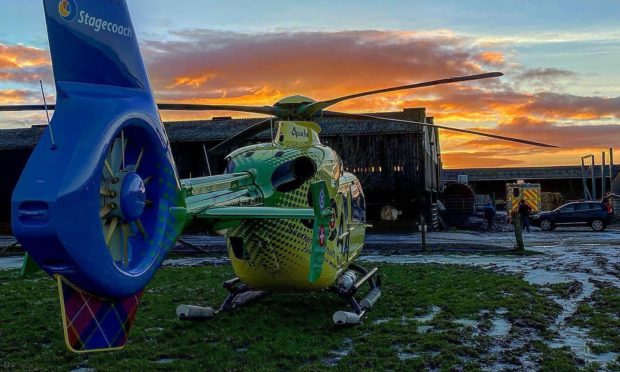From snowy ski slopes and wind-buffeted remote islands to pitch-black roadsides and sunny beaches, the crew of Helimed 79 has experienced all the seasons of Scotland in its first year of operation.
SCAA’s (Scotland’s Charity Air Ambulance) second aircraft, based in Aberdeen, has travelled almost 22,000 nautical miles since its launch 12 months ago.
Not only can it travel to emergency locations further and faster than a road ambulance, but it can also traverse conditions others would not manage.
To mark the service’s one-year anniversary, The P&J has been given exclusive access to some of its extensive flight records, showing just how many communities its team has touched.
‘We have to be prepared’
Of the 195 incidents Helimed 79 was called to over the year, around two-thirds were in the Grampian NHS region.
The remainder were largely split between Orkney and the Highlands, with a handful in Tayside.
Kirkwall experienced the most call-outs with 15, while Banff on the Aberdeenshire coast followed closely behind with 11.
Other hotspots included Wick, Keith, Alford and Aboyne.
In recent weeks, the team has also been tasked with jobs in the Borders, flying to Duns and Kelso.
Team leader Ewen Littlejohn said: “When we get a call in we get a grid reference, but that can change and get updated.
“You can be in a car park one day, a farm the next, a beach – you’re all over the place.
“But that’s the benefit we add. With an early call-out, we can get on scene quickly and get the patient away without any extended carrying on stretchers or mats.”
Pilot Pete Winn said: “Patient care really does benefit from us being able to get to those locations and get the patient quickly to hospital.
“Geographically, we’ve been as far as Skye and Kinlochbervie – there’s a huge spread of geographical areas we can cover with the air ambulance. It’s great.
“But generally the weather is something we’d have to think about and, when you add the mountains, it’s another step up other places in the UK wouldn’t have to deal with.
“We’ve had some interesting landings and it really shows the variety of the places we go.
“Seasons can change in a heartbeat in Scotland, so we have to be prepared for that.”
Vital service
Amidst the recent cold weather, the Helimed 79 crew found themselves indispensable during several crisis situations, helping where others could not.
This included a vital call-out to the Glenshee ski resort, where they had to battle the weather just to arrive, and another at Pitfichie, where they landed to rescue an injured mountain biker as night closed in.
Mr Littlejohn said: “There are two ends to this.
“There’s getting the paramedic care to the patient as quickly as possible so, if the ambulance isn’t going to be there quickly, it’s about getting us there so we can start administering life-saving treatments.
“The other is getting the patient to hospital as speedily as we can.
“And, especially when the roads were really bad with snow, there were ambulances getting stuck left, right and centre.
“We don’t have to worry about that.”
During another call-out, the aircraft had to land on a sandy beach near St Fergus, after a young girl tripped and fractured her leg.
Paramedic Laura McAllister said: “It was inaccessible to the ambulance crew.
“They still couldn’t get there after 15 to 20 minutes as it was over the dunes and really hard to get to.”
The wide reach of Scaa’s Helimed 79 also has another advantage, in freeing up resources for communities where they are scarce.
This proved vital on one occasion where the crew was tasked with a job in Kinlochbervie.
Mr Winn said: “The drive from there to Raigmore in Inverness is absolutely huge – probably about five or six hours.
“And during that time, the whole area doesn’t have an ambulance in those parts.
“Given the large distances, we can keep these road resources nearer these outlying communities.
“So if there’s another heart attack or accident, they can be there straight away and we can backfill them again.”
Scotland’s Charity Air Ambulance has made a huge impact since 2013, saving lives and preventing suffering.
That is why the P&J campaigned successfully for Scaa’s second helicopter to be based in our region.
It has now been a year since the aircraft – call sign Helimed 79 – started flying missions from Aberdeen Airport.
But this is an emergency service that relies entirely on donations.
Each call-out costs about £2,500 and SCAA needs P&J readers to help hit its £6million target to cover the cost of its first three years operating in the north-east.
So please do anything you can to raise those funds and show that We’re Backing Helimed 79.
Ways to donate to SCAA
- Website: www.scaa.org.uk/donate
- Text: Text ‘SCAA’ and the amount to 70085
- Phone: 03001231111
- Cheques: Made payable to ‘SCAA’ or ‘Scotland’s Charity Air Ambulance’ and sent to: Scotland’s Charity Air Ambulance (SCAA), The Control Tower, Perth Airport, Scone, PH2 6PL









